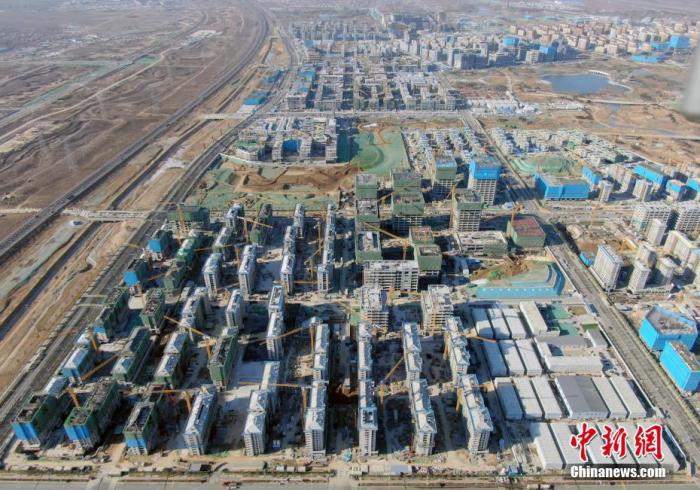(Economic Observation) "Dislocation" and "Synergy" of Xiongan New Area in the Fifth Anniversary of Rapid Change
China News Agency, Beijing, April 1st (Wang Enbo and Liu Wenwen) From a "white paper" and a blueprint, to the hanging towers and the boom, since its establishment 5 years ago, the Xiong'an New District has been changing with each passing day, and it has now entered the role of undertaking non-capital functions in Beijing. It is an important stage of simultaneous advancement of relief and construction.
In this process, there is not only a precise division of labor that is complementary to each other, but also a concerted effort for coordinated development.
Coordinating regional economic development, straightening out relations and clear positioning are crucial.
Jia Ruoxiang, director of the Comprehensive Research Office of the Institute of Land Development and Regional Economics of the National Development and Reform Commission, said in an interview with a reporter from China News Agency that in the coordinated development of Beijing-Tianjin-Hebei, Beijing, Tianjin and Hebei have corresponding functional orientations.
Data map: Aerial photography of the construction site of the Xiong'an Huawangcheng project.
The office area of the project will focus on connecting and easing state-owned enterprises, and will create a comprehensive functional area that is livable and suitable for business.
Photo by China News Agency reporter Han Bing
For example, Tianjin is more focused on undertaking the transfer, transformation and industrialization of Beijing's scientific research achievements.
Tianjin also has a special shipping function, and the development of its port technology and port industry requires the coordinated efforts of Beijing and Tianjin and even a wider range.
As a province with a large population, Hebei must follow the requirements of high-quality development, ecological priority and green development, and promote new urbanization and industrial transformation and upgrading.
Specifically, Xiongan New Area is different from new areas in the general sense. Its positioning is first to relieve Beijing's non-capital functions, and focus on undertaking administrative institutions, headquarters enterprises, financial institutions, colleges and universities, and scientific research institutes released by Beijing. and so on, with the starting point of solving Beijing's "big city disease" problem.
Jia Ruoxiang pointed out that the establishment of Xiong'an is closely related to the relief of Beijing's functions, which will help support the capital's "slimming and fitness" and higher-quality development.
This undertaking process itself is also a process of promoting the iterative upgrading of the industry, improving quality and efficiency. "Xiongan was born to relieve Beijing's non-capital functions, and it also thrives by undertaking Beijing's non-capital functions."
In the past five years, the four beams and eight columns that Xiongan New Area has undertaken to undertake Beijing's non-capital functions have basically taken shape, forming a batch of high-quality landmark achievements.
Starting from 2021, some universities, hospitals and central enterprise headquarters affiliated to ministries and commissions in Beijing have started to release them to the new area in stages and in batches.
For example, the first batch of three state-owned enterprises, including China Star Network, have settled in, and have completed site selection and started the construction process; a number of market-oriented relief projects, such as China Telecom Xiongan Internet Industrial Park, have also started construction in the start-up area of the new district.
As of March this year, more than 100 state-owned enterprises have set up branches in Xiongan New Area.
In the past five years, there have been more than 3,600 Beijing investment source enterprises registered at the same level in the new district, accounting for more than 80% of the total.
The carrying capacity, agglomeration capacity and attractiveness of the Xiongan New Area have been continuously enhanced, and the optimization of its regional economic layout and the synergy of the internal functions of the Beijing-Tianjin-Hebei urban agglomeration have also continued to emerge.
Shi Minjun, director of the Xiong'an Development Center of Zhejiang University, believes that the Xiong'an New Area is located in the hinterland of Beijing, Tianjin and Baoding, and this site selection covers many considerations for promoting regional coordinated development.
On the one hand, Xiongan New Area can play the role of "anti-magnetic force" by undertaking non-capital functions to break the spatial pattern of polarized flow of elements, and to a certain extent, resolve the negative impact of the siphon effect on the balanced development of Beijing-Tianjin-Hebei space.
Data map: Aerial photography of the construction site of the Rongxi area of Xiongan New Area.
The Rongxi area of Xiong'an New District is a comprehensive urban area that is livable and suitable for business with the main functions of living and living.
(UAV photo) Photo by China News Agency reporter Han Bing
On the other hand, Xiongan New Area can be used as a part of the capital circle to support the functional reconstruction of the capital circle in the Beijing-Tianjin-Hebei urban network, and to promote the collaboration and interaction between the functions of the Beijing capital and the construction of the world-class urban agglomeration in Beijing-Tianjin-Hebei.
On this basis, the Xiongan New Area can radiate and drive the industrial transformation and economic development in the central and southern Hebei region, and reverse the situation that the development capacity gap within the Beijing-Tianjin-Hebei region is too large.
When it comes to the future development direction, experts believe that it is still the key to grasp the "dislocation synergy".
Jia Ruoxiang said that the Xiongan New Area is an important functional area in the entire Beijing-Tianjin-Hebei urban agglomeration. It is necessary to aim at its own functional positioning, strengthen its own advantages and strengths, and play a large, strong and good role in undertaking Beijing's non-capital functions. Provide support and contribution to the development of the entire urban agglomeration.
(over)

